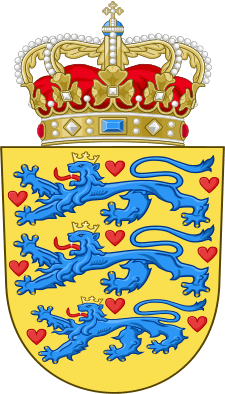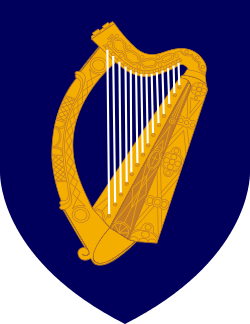Denmark–Ireland relations
 |
|
Denmark |
Ireland |
|---|---|
Denmark–Ireland relations refers to the current and historical relations between Denmark and Ireland. Denmark has an embassy in Dublin,[1] and Ireland has an embassy in Copenhagen.[2] Diplomatic relations were established in January 1962.[3] Both countries have since 1973 been members of the European Union.
History
20th century
During the 19th century, many historians have commented on the differences between the Danish and Irish economies.[4] Both countries were mostly agricultural and both countries were great import countries of the British market. Especially, bacon, eggs and butter. So there were competition between the two countries. Even Horace Plunkett said in 1908; "I have always felt that Ireland a second Denmark was no bad ideal for our reformers to set before them."[4][5]
In 1943, Irish historian J.P. Beddy wrote:
Denmark is not only a smaller country than Eire but her climate is less equable, her soils are, in general, lighter and poorer, she has no coal and no water power to compensate for its absence, nor has she any iron ore or other metallic ores to serve as a basis for industrial activities. Yet, in comparison with Eire, she has a bigger population, a greater agricultural output, a more extensive industrial system, a larger foreign trade, a lower national debt, a higher national income and a better standard of living. It is the purpose of this paper to throw some light on this unusual economic paradox. [sic]— J.P. Beddy, [4]
Many Irish historians and economists have compared the two countries; Raymond Crotty in 1966, Cormac Ó Gráda in 1977 and Joseph Lee in 1989.[4]
Current relations
When both countries joined the European Union, Denmark opened an embassy in Dublin.[6] Denmark lent 400 million euro to Ireland in 2010 as a rescue deal.[7]
Cooperation and trade
An air transport treaty was signed in 1947, between both countries.[8] In 1993, both countries signed a double taxation treaty.[9] In 2008, Danish export to Ireland amounted 5,8 billion DKK, while Irish exports amounted 5,9 billion DKK.[10][11]
Expatriates
About 1000 Danes live in Ireland.[12]
See also
References
- ↑ "Danish embassy in Dublin, Ireland". Government of Denmark. Ministry of Foreign Affairs (Denmark). Retrieved 1 June 2011.
- ↑ "Irish embassy in Copenhagen, Denmark". Government of the Republic of Ireland. Department of Foreign Affairs. Retrieved 1 June 2011.
- ↑ Ireland today (2). Information Section, Dept. of Foreign Affairs. 1983. p. 177. Retrieved 7 April 2011.
Diplomatic relations with Denmark were established on a non-residential basis in January 1962 and the first resident Ambassador presented his credentials in May 1970. Although this was the first visit of an Irish Head of State
- 1 2 3 4 H. O’Rourke, Kevin (March 2004). "Department of Economics and IIIS, Trinity College Dublin" (PDF). Trinity College, Dublin: 68.
- ↑ Ó Gráda (1977), p. 298.
- ↑ "Denmark and Ireland". Government of Denmark. Retrieved 1 June 2011.
- ↑ "Danmark giver Irland stort nødlån". Ekstra Bladet (in Danish). 28 November 2010. Retrieved 1 June 2011.
- ↑ "Denmark and Ireland: Exchange of notes constituting an agreement relating to air transport. Dublin, 18 November 1947" (PDF) (561). United Nations. 18 November 1947: 7. Retrieved 2 June 2011.
- ↑ Convention between Ireland and the Kingdom of Denmark for the avoidance of double taxation and the prevention of fiscal evasion with respect to taxes on income. The Stationery Office. 1993. p. 41. Retrieved 2 June 2011.
- ↑ "Landefakta Irland" (in Danish). Retrieved 20 November 2011.
- ↑ "Trade between Denmark and Ireland" (PDF). Statistics Denmark. Danish embassy in Dublin, Ireland. p. 12. Retrieved 2 June 2011.
- ↑ "Danskere i Irland" (in Danish). Retrieved 1 June 2011.
Further reading
- "EU Facts: Ireland and Denmark". CIVITAS. Retrieved 1 June 2011.
- Frank J. Geary (1925). Denmark and Ireland: some facts for the Irish farmer. Irish Independent. p. 110. Retrieved 2 June 2011.
- Paul Whitaker (1997). Collaboration in Denmark and Ireland: an examination of the co-operative system: are there lessons to be learnt?. University College Dublin. p. 129. Retrieved 2 June 2011.
- Nils Karl Sorensen; Bent Dalum; Erik Strøjer Madsen; Jorgen Ulff-Moller Nielsen (1991). Intra-industry trade in Denmark and Ireland: a comparison. Aarhus University. Retrieved 2 June 2011.

